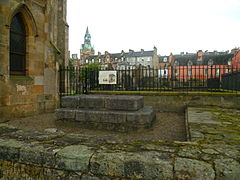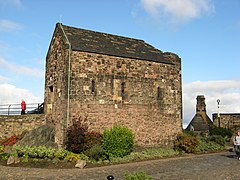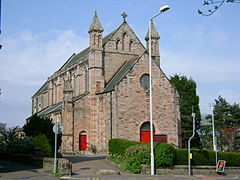Saint Margaret of Scotland
| Saint Margaret of Scotland | |
|---|---|
Queen consort of Scotland | |
| Tenure | 1070 – 13 November 1093 |
| Born | c. 1045 Kingdom of Hungary |
| Died | 16 November 1093 (aged 47–48) Edinburgh Castle, Edinburgh, Kingdom of Scotland |
| Burial | |
| Spouse | Malcolm III of Scotland (m. 1070; died 1093) |
| Issue more... |
|
Catholicism | |
Saint Margaret of Scotland (
Margaret was a very pious
In 1250,
.Early life
Margaret was the daughter of the English prince Edward the Exile and his wife Agatha, and also the granddaughter of
Return to England
Margaret came to England with the rest of her family when her father,
Journey to Scotland
According to tradition, the widowed Agatha decided to leave Northumbria, England with her children and return to the continent. However, a storm drove their ship north to the Kingdom of Scotland, where they were shipwrecked in 1068. There they were given refuge by King Malcolm III. The locus where it is believed that they landed is known today as St Margaret's Hope. Margaret's arrival in Scotland, after the failed revolt of the Northumbrian earls, has been heavily romanticised, though one medieval source suggested that she and Malcolm were first engaged nine years earlier. That is, according to Orderic Vitalis, one of Malcolm's earliest actions as king was to travel to the court of Edward the Confessor, in 1059 to arrange a marriage with "Edward's kinswoman Margaret, who had arrived in England two years before from Hungary".[2] If a marriage agreement was made in 1059, it was not kept, and this may explain the Scots invasion of Northumbria in 1061 when Lindisfarne was plundered.[3] Conversely, Symeon of Durham implied that Margaret's first meeting with Malcolm III may not have been until 1070, after William the Conqueror's Harrying of the North.
Malcolm III was a widower, with two sons, Donald and Duncan, and would have been attracted to marrying one of the few remaining members of the
Progeny
Margaret and Malcolm had eight children – six sons and two daughters:
- Edward (c. 1071 – 13 November 1093), killed along with his father in the Battle of Alnwick
- Edmund (c. 1071 – post-1097)
- Ethelred, abbot of Dunkeld, Perth and Kinross, Scotland
- Edgar(c. 1074 – 11 January 1107), king of Scotland, reigned 1097–1107
- King of Scotland, reigned 1107–24
- Edith(c. 1080 – 1 May 1118), renamed Matilda, queen of England
- Mary(1082–1116), countess of Boulogne
- David I (c. 1084 – 24 May 1153), king of Scotland, reigned 1124–53
Piety

Margaret's biographer
"The chroniclers all agree in depicting Queen Margaret as a strong, pure, noble character, who had very great influence over her husband, and through him over Scottish history, especially in its ecclesiastical aspects. Her religion, which was genuine and intense, was of the newest Roman style; and to her are attributed a number of reforms by which the Church [in] Scotland was considerably modified from the insular and primitive type which down to her time it had exhibited. Among those expressly mentioned are a change in the manner of observing Lent, which thenceforward began as elsewhere on Ash Wednesday and not as previously on the following Monday, and the abolition of the old practice of observing Saturday (Sabbath), not Sunday, as the day of rest from labour (for more information on this issue see Skene's Celtic Scotland, book ii chap. 8)."
She attended to charitable works, serving orphans and the poor every day before she ate and washing the feet of the poor in imitation of Christ. She rose at midnight every night to attend the
Margaret was as pious privately as she was publicly. She spent much of her time in prayer, devotional reading, and ecclesiastical embroidery. This apparently had considerable effect on the more uncouth Malcolm, who was illiterate: he so admired her piety that he had her books decorated in gold and silver. One of these, a

Malcolm was apparently largely ignorant of the long-term effects of Margaret's endeavours, not being especially religious himself. He was content for her to pursue her reforms as she desired, which was a testament to the strength of and affection in their marriage.[7]
Death
Her husband
Veneration
Canonization and feast day
| Canonized | 1250 by Pope Innocent IV |
|---|---|
| Major shrine | Dunfermline Abbey (until 1560) |
| Feast | 16 November |
| Patronage | Scotland |

She is also venerated as a saint in the
Institutions bearing her name
Several churches throughout the world are dedicated in honour of St Margaret. One of the oldest is St Margaret's Chapel in Edinburgh Castle in Edinburgh, Scotland, which her son King David I founded. The Chapel was long thought to have been the oratory of Margaret herself, but is now thought to have been established in the 12th century. The oldest edifice in Edinburgh, it was restored in the 19th century and refurbished in the 1990s.
-
Site of the ruined Shrine of St. Margaret at Dunfermline Abbey, Fife, Scotland
-
-
St Margaret's Church in Dunfermline, Fife, Scotland
See also
- List of Catholic saints
- List of Scottish consorts
- St Margaret's Chapel, Edinburgh
- Glasgow University
- Glasgow University
- Saint Margaret of Scotland, patron saint archive
References
Citations
- ^ a b c "St. Margaret Queen of Scotland", St.Margaret of Scotland Church, Selden, New York Archived 16 May 2013 at the Wayback Machine
- ^ Duncan, p. 43; Ritchie, pp. 7–8.
- ^ Duncan, p. 43; Oram, David I, p. 21.
- ^ Marshall 1907, p. 55.
- ^ Menzies, Lucy (2007). St. Margaret Queen of Scotland (reprint ed.). Edinburgh: The St. Margaret's Chapel Guild. pp. 16–23.
- ^ "St Margaret's Cave". VisitScotland. Archived from the original on 10 September 2011. Retrieved 18 March 2011.
- ^ ISBN 1-84119-096-9.
- ^ Dalrymple, Sir David (1776). Annales of Scotland. Vol. 1 : From the accession of Malcolm III. surnamed Canmore, to the accession of Robert I. Balfour & Smellie. pp. 40–.
- ISBN 978-0-19-280058-9.
- ^ a b Keene 2013, p. 134.
- ^ https://www.stgregoryoc.org/st-margaret-of-scotland/
- ^ Keene 2013, p. 121.
- ^ "Calendarium Romanum" (Libreria Editrice Vaticana, 1969), p. 126
- ^ "The Calendar". The Church of England. Retrieved 27 March 2021.
- ISBN 978-1-64065-235-4.
Sources
- Chisholm, Hugh, ed. (1911). . Encyclopædia Britannica. Vol. 17 (11th ed.). Cambridge University Press. p. 701.
- Duncan, A.A.M., The Kingship of the Scots 842–1292: Succession and Independence. Edinburgh University Press, Edinburgh, 2002. ISBN 0-7486-1626-8
- Keene, Catherine (2013). Saint Margaret, Queen of the Scots: A Life in Perspective. Springer. ISBN 978-1-137-03564-6.
- Marshall, Henrietta Elizabeth (1907). "Ch. XIII Malcolm Canmore - How Saint Margaret Came to Scotland". Scotland's Story: A History of Scotland for Boys and Girls. Thomas Nelson.
- Oram, Richard, David I: The King Who Made Scotland. Tempus, Stroud, 2004. ISBN 0-7524-2825-X
- Ritchie, R. L. Graeme, The Normans in Scotland, Edinburgh University Press, 1954
Further reading
- Chronicle of the Kings of Alba
- Anderson, Marjorie O. (ed.). Kings and Kingship in Early Scotland. 2nd ed. Edinburgh, 1980. 249-53.
- Hudson, B.T. (ed. and tr.). Scottish Historical Review 77 (1998): 129–61.
- Anderson, Alan Orr (tr.). Early Sources of Scottish History: AD 500–1286. Vol. 1. Edinburgh, 1923. Reprinted in 1990 (with corrections).
- Turgot of Durham, Vita S. Margaritae (Scotorum) Reginae.
- Ed. and trans. Catherine Keene, in Saint Margaret, Queen of the Scots: A Life in Perspective, New York, 2013, Appendix: Translation of the Dunfermline Vita, pp. 135–221.
- Ed. J. Hodgson Hinde, Symeonis Dunelmensis opera et collectanea. Surtees Society 51. 1868. 234-54 (Appendix III).
- tr. William Forbes-Leith, SJ, Life of St. Margaret, Queen of Scotland by Turgot, Bishop of St Andrews. Edinburgh, 1884. PDF available from the Internet Archive. Third Edition. 1896.
- Trans. anon., The Life and Times of Saint Margaret, Queen and Patroness of Scotland. London, 1890. PDF available from the Internet Archive.
- William of Malmesbury, Gesta regum Anglorum.
- Ed. and trans. R. A. B. Mynors, R. M. Thomson, and M. Winterbottom, William of Malmesbury. Gesta Regum Anglorum. The History of the English Kings. OMT. Vol 1. Oxford, 1998.
- Orderic Vitalis, Historia Ecclesiastica
- Ed. and trans. Marjorie Chibnall, The Ecclesiastical History of Orderic Vitalis. 6 vols. OMT. Oxford, 1968–80.
- John of Worcester, Chronicle (of Chronicles).
- Ed. B. Thorpe, Florentii Wigorniensis monachi chronicon ex chronicis. 2 vols. London, 1848-9.
- Trans. J. Stevenson, Church Historians of England. Vol. 2.1. London, 1855. P. 171–372.
- John Capgrave, Nova Legenda Angliae
- Acta Sanctorum Vol. 2, June, 320. London, 1515. 225.
- Secondary literature
- Baker, D. "A Nursery of Saints: St Margaret of Scotland Reconsidered." In Medieval Women, ed. D. Baker. SCH. Subsidia 1. 1978.
- Bellesheim, Alphons. History of the Catholic Church in Scotland. Vol 3, trans. Blair. Edinburgh, 1890. pp. 241–63.
- Butler, Alban. Lives of the Saints. 10 June.
- Challoner, Richard. Britannia Sancta, I. London, 1745. P. 358.
- Dunlop, Eileen, Queen Margaret of Scotland, 2005, NMS Enterprises Limited – Publishing, Edinburgh, 978 1 901663 92 1.
- Huneycutt, L.L. "The Idea of a Perfect Princess: the Life of St Margaret in the Reign of Matilda II (1100–1118)." Anglo-Norman Studies, 12 (1989): pp. 81–97.
- Madan. The Evangelistarium of St. Margaret in Academy. 1887.
- Parsons, John Carmi. Medieval Mothering. 1996.
- Olsen, Ted. Kristendommen og Kelterne Forlaget. Oslo: Forlaget Luther, 2008. (P. 170). ISBN 978-82-531-4564-8. Norwegian.
- Skene, W.F. Celtic Scotland. Edinburgh.
- Stanton, Richard. Menology of England and Wales. London, 1887. P. 544.
- Wilson, A.J. St Margaret, Queen of Scotland. 1993.
External links
- Margaret 1 at Prosopography of Anglo-Saxon England
- Portraits of Queen Margaret of Scotland at the National Portrait Gallery, London
- The Heraldry of Queensferry, which provides the best information and images, interspliced throughout the page, on St. Margaret's arms and their variations.
- University of Pittsburgh: Margaret of Scotland
- Catholic Encyclopedia: St. Margaret of Scotland
- Medieval Women: The Life Of St Margaret, Queen Of Scotland By Turgot, Bishop of St Andrews Ed. William Forbes-Leith, S.J. Third Edition. Edinburgh: David Douglas, 1896 . Retrieved 14 March 2011.



